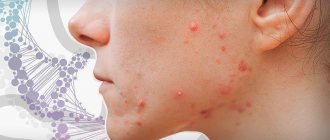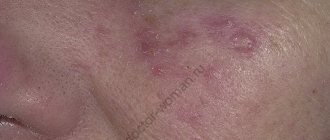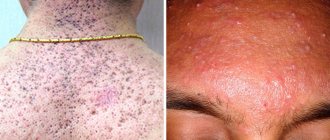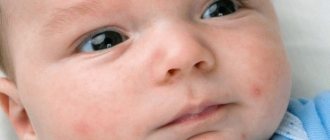Features of dry facial skin
Dry skin is often confused with dehydrated skin. However, these concepts have fundamental differences. Dehydrated skin looks loose and is characterized by deep and long wrinkles. She suffers from a lack of moisture due to changes in the intercellular matrix of the dermis. But this problem can occur with both normal and oily skin.
Dry skin has impaired barrier properties, so it lacks not only moisture, but also fatty lubrication. In addition, dehydration can be eliminated, while skin type is determined at the genetic level.
Although in both cases the skin feels a lack of water, the methods of moisturizing will be radically different. This is due to the level of external influences and structural changes that led to the shortage.
How to deal with sagging and dry skin
Seeing dry, flabby skin with reduced turgor, cosmetologists often recommend a biorevitalization - i.e. injection of hyaluronic acid into the dermal layer of the skin. Which, by the way, comes out very quickly (from 2 to 5 days).
There is no need to rush into replacement therapy because:
- This does not solve the problem of dry skin and impaired barrier function.
- Why introduce a foreign product when the skin itself is able to compensate for the resulting deficiency by eliminating the causes of its formation.
Signs of dry facial skin
One of the main indicators of dry skin is the absence of oily shine. Try going without makeup or skincare products for a few hours, and then pat your skin dry with a tissue. If there is no oily shine, most likely you have a dry type. There are other signs that point to it:
- feeling of tightness,
- high sensitivity,
- severe dryness in winter,
- invisible pores
- no rashes, pimples,
- frequent peeling
- early signs of aging (wrinkles).
Causes of dry facial skin
Dry skin is characterized by tightness, flaking, dull tone, regular irritation and a finely porous structure. These features are genetic and associated with insufficient production of sebum and low activity of the sebaceous glands.
This is why dry skin has a very thin hydrolipid barrier. It consists of water, fatty acids and in normal condition protects the skin from negative factors. But in the dry type, this barrier functions poorly, which leads to negative consequences: disruption of the lipid and water barrier, weak functioning of the sweat and sebaceous glands, and a slightly acidic pH reaction (acid-base state).
Despite the fact that your skin type is given at birth, you can choose the right skin care products and get rid of the negative features inherent in dry skin.
What happens inside the skin
Information for specialists
The appearance of sagging skin is associated with disturbances in the structure of the dermal layer of the skin:
- Changes in the structure and functioning of fibroblasts - they become more rigid and flat, their synthetic activity decreases, which leads to a decrease in the viscoelastic properties of collagen.
- An insufficient amount of collagen and a violation of its structure leads to impaired contact between fibers and fibroblasts, which for normal functioning must be in a stretched, spindle-shaped state.
- This is how a “vicious circle” arises : lack of collagen synthesis <=> dysfunction of fibroblasts.
Such changes most affect the fibroblasts of the papillary dermis, which primarily affects the normal structure of the papilla of the epidermal-dermal junction.
There is a smoothing of the papillae, which manifests itself in the initial stages as sagging skin. There is a feeling of insufficient tension and elasticity, subsequently ptosis and wrinkles form .
How to care for dry skin
Rules for caring for dry skin involve internal and external effects on the body. You should add to your diet dishes with vitamin E (radish, nuts, corn), A (fish oil, broccoli, tomatoes), and group B: fish, dairy products, bread.
It is also important to take care of the outside of your skin. Use special products regularly: they have a cumulative effect, so interrupting care is not recommended.
- Always cleanse your skin of makeup.
- Use skin care creams not only for your face, but also for your hands and feet.
- You need to moisturize your skin twice a day: in the morning (at least half an hour before going outside) and in the evening, an hour before bedtime.
- During sleep, skin cells are restored, and due to lack of sleep, the barrier function deteriorates, hydration decreases, and tone changes. So don't neglect your sleep.
Treatment of dermatitis
Treatment tactics for dermatitis depend on the cause and form of the disease. General recommendations for the patient include:
- establishing a work and rest schedule, sleeping at least 8 hours a day;
- a diet based on limiting fried, spicy and canned foods, possible food allergens;
- carrying out hygiene procedures in warm water (not higher than 34°C);
- eliminating stress and nervous overload.
In case of severe itching, accompanied by sleep disturbances and neurological disorders, the prescription of sedatives, mainly of herbal origin, is indicated.
It is important to stop contact of irritants with the skin or internal environment of the body as soon as possible. To achieve this, cleansing and general detoxification measures are carried out:
- in case of chemical exposure to the skin, it is thoroughly washed and a bandage is applied with a neutralizing substance - alkali for an acid burn or an acid for an alkali burn;
- for perioral, drug-induced and allergic dermatitis, after washing the skin, enterosorbents, a hypoallergenic diet, and in severe cases, intravenous infusions of special solutions are prescribed;
- Treatment of parasitic infestation is carried out using anthelmintic drugs.
Also in the treatment of dermatitis, antihistamines, antibiotics and antifungals are used both locally, on the skin, and systemically.
Wet areas of the skin can be treated with antiseptic solutions and herbal infusions that have a drying effect. Hormonal ointments for dermatitis have an anti-inflammatory effect. Severe itching and pain, as well as a large area of damage and the appearance of areas of tissue necrosis, are indications for urgent hospitalization of the patient. In case of severe disease with damage to more than 20% of the skin, a course of prednisolone tablets is recommended. In such situations, treatment may be supplemented with immunosuppressive drugs.
Author:
Pugonina Tatyana Alekseevna, Therapist
Features of seasonal skin care
Daily care for dry skin is the main guarantee of freshness and tone at any time of the year. However, specific care is largely related to humidity, temperature and other weather conditions.
in winter
During this period, the most dramatic temperature changes begin: it is cold and windy outside, and the air at home is hot and dry. Therefore, the skin dries out even more and needs intensive care. Apply the cream daily, and at least half an hour before leaving the house, use skincare products so that they are better absorbed.
in spring
In the first half of spring, frost and wind persist, and therefore intensive protection is still important. Products with a lighter texture are suitable. It’s also worth buying a cream or lip balm: they need care all year round, but in the spring they become chapped especially badly.
In summer
In summer, ultraviolet radiation has a particularly strong effect on the skin. Use skincare products for regeneration (for example, with aloe vera extract) and moisturizing: it is best to apply it in the evening.
in autumn
After a hot summer, skin care is especially important: it suffers from increased dryness. We need to prepare her for the coming cold weather. At this time, nourishing and moisturizing products are suitable.
Why cleanse and tone your skin?
The main stages of skin care are cleansing and toning. They should be performed 2 times a day. Daily facial skin care at home depends on the condition of the skin.
Cleansing is an important stage of skincare procedures. Using makeup and cosmetics without first cleansing will be ineffective - the skin and pores are contaminated, which provokes the appearance of pimples and minor blemishes. Even if you don’t use decorative cosmetics, you still need to cleanse your skin.
Daily facial skin care at home cannot be complete without cleansing. During the night, the skin intensively produces sebum. Morning procedures will help remove excess sebum and prepare the skin for the use of day cream.
Proper daily facial skin care must include evening cleansing of dirt and makeup residues. After cleansing, the skin is able to absorb the nutrients contained in the creams. The main rule is to use special products to cleanse the thin skin around the eyes.
If everything is clear with cleansing, then why does the skin need toning? The normal pH of human skin is 3.5-5.5. The skin is covered by a lipid layer called the acid mantle. Washing disrupts the acidity of the skin, as products often contain alkalis. After some time, the skin itself is able to restore its pH, but a tonic will help speed up this process.
Facial skin care every day includes toning. Tonics perform several tasks:
- help neutralize the effects of cleansers
- stabilize skin pH after cleansing
- prepare the skin for applying the cream
- improve the penetration of nutrients into the deep layers of the dermis
Daily skin care for the face and neck means using toners in the morning and evening. The toner restores pH and eliminates the feeling of tightness. The toning effect will not be long in coming - the skin becomes moisturized and velvety, skin pores narrow, and inflammatory processes decrease.
Mistakes in caring for dry skin
Not everyone understands how to care for dry skin. Of course, dryness is aggravated due to sea and chlorinated water, natural factors such as wind, cold, dry air, exposure to ultraviolet radiation, as well as a deficiency of vitamins A, B, E. But some reasons are related to a person’s lifestyle. Check if you are making any mistakes:
- often go to the solarium or to the beach,
- have bad habits: alcohol, smoking, caffeine addiction,
- wash your face with hot water or take an excessively hot bath,
- do strong peelings or use cleansing masks,
- use alcohol lotions and alkaline soaps,
- limit yourself in every possible way in your diet,
- You don't moisturize your skin at all.
Proper care and a healthy lifestyle will relieve your skin of tightness, flaking and discomfort. But incorrect care for very dry skin will only worsen its condition.
Diagnosis of dermatitis
The diagnosis is made based on the existing symptoms, the results of an external examination of the patient’s skin and mucous membranes, visual assessment and localization of pathological changes.
An anamnesis of the disease must be studied in order to establish the possible cause of dermatitis and its genetic cause. Laboratory diagnosis of dermatitis includes the following studies:
- General clinical blood test. During an allergic reaction, an increase in the number of eosinophils is observed, and an accelerated ESR indicates inflammation.
- Blood chemistry. Includes determination of the concentration of AST, ALT, total bilirubin, triglycerides, cholesterol, total protein.
- Determination of the level of immunoglobulins in blood serum, antibodies to food, household antigens, antigens of plant, animal and chemical origin.
If necessary, it is possible to conduct a histological examination of the biomaterial obtained through skin biopsy. Genetic blood testing helps determine hereditary predisposition to the development of atopic disease. In the presence of a purulent process or severe inflammation, a microscopic and bacteriological examination of the smear is prescribed in order to clarify the causative agent. Additionally, for dermatitis, tests are carried out for giardiasis and other forms of intestinal parasites, and the organs of the digestive tract are examined.
How to choose dry skin care products
Proper care for dry skin is largely due to the lack of necessary care products.
- Look for the inscription “For dry skin”: these products contain the most useful substances.
- Avoid products with alcohol, alkalis, aggressive surfactants, and mineral oils: they make the skin drier and cause a feeling of tightness.
- Also, do not use products with clay: it draws out moisture.
- Use products that contain antioxidants, ceramides, glycerin, and natural oils - they moisturize the skin well.
Ceramides must be included in skincare products for dry skin. They are the key elements of the stratum corneum. These natural lipids, along with fatty acids, form the lipid layer of the skin. They, like cement, connect the cells of the epidermis and hold water molecules, thereby maintaining the moisture of the stratum corneum.
Thanks to their properties, ceramides fight damage to the cell structure. This applies to defects caused by external factors and skin diseases: psoriasis, atopic dermatitis. In this case, you should use different skincare cosmetics for different parts of the body - face, lips, hands and feet.
- The thin skin on the lips reacts most quickly to environmental influences. So lips need special attention and careful care. Ultra-hydrating Cera Lip Balm with Vitamin E nourishes delicate skin, protecting it in any weather. It prevents the appearance of cracks, promotes regeneration and is suitable as a base for lip makeup - so you can use the balm at any time of the day.
- Lack of moisture causes dryness, discomfort, and loss of elasticity of the facial skin. Therefore, it is important to provide her with water. Ultra-moisturizing Cera Cream for face and body restores the protective layer, soothes the skin and serves as an excellent base for makeup.
- The skin of the hands is exposed to the highest stress. It is affected by water quality, sunlight, and mechanical work. Ultra-moisturizing hand cream with ceramides is suitable for sensitive, very dry and irritation-prone skin. It reduces the feeling of discomfort, is quickly absorbed and does not leave a sticky film.
- The skin of the feet has the least amount of sebaceous glands, which is why it is most susceptible to dryness. Due to constant stress, the skin of the feet becomes rough and the heels crack. Ultra-moisturizing cera cream eliminates cracks and corns, moisturizes and softens rough skin.
Endocrine diseases. Self-diagnosis
Murzaeva Irina Yurievna
Endocrinologist, Preventive Medicine Doctor
September 3, 2017
Unfortunately, the practice of annual medical examinations and mass disease prevention in kindergartens and schools are gradually becoming a thing of the past. Remember, they used to give fish oil, iodine preparations - Antisturmin, etc. for breakfast. Health magazine taught people all over the country to self-diagnose breast tumors, provide first aid to themselves and others... Times change, not always for the better, but this is a separate topic. The motto of “our intertime” is help yourself.
Today I will tell you how to suspect one or another endocrine disease when examining your own body . Just suspect and consult a doctor, and not start treating yourself!
Information about this mysterious photo is below. 
So let's start with SKIN .
It occupies a huge surface area of the body, performs many functions and is the first to respond to changes in the body.
Dryness, peeling (scales) of the skin of the face, torso, arms and legs
- often this is a sign of hypothyroidism (reduced thyroid function), and this is most clearly visible in the dryness and flaking of the elbows, sometimes as a “flour” type, dry elbow with a white coating;
- It can also be a sign of severe dehydration. Take a closer look to see if you have any new wrinkles;
- allergies can always be distinguished - peeling with bright pinpoint rashes and itching;
- peeling and cracking of the fingers - often this is a manifestation of anemia or liver pathology (fatty hepatosis and other diseases);
- But if your feet are dry and flaky, get checked for fungal diseases and diabetes.
What a seemingly insignificant symptom, but so much information.
Acantosis nigricans - I can only write here in Latin, the symptom is extremely important, this is the appearance of dark-colored foci of pigmentation (similar to a tan) in places where clothing rubs: neck, armpits, groin area, under the breasts, on the elbows, a sign of incipient diabetes, or prediabetes. This symptom is also called a sign of insulin resistance (the body’s metabolism of the hormone insulin, which is responsible for the absorption of sugar from food, is disrupted). The symptom is terrible, it also happens in children, and is often a sign of hereditary insulin resistance.
You need to go to an endocrinologist as soon as possible!
Pigmentation is a very broad concept; spots come in different colors and sizes.
A bronze tint of the skin over the entire surface of the body, especially increasing in winter, is a sign of another formidable disease - adrenal insufficiency. It is urgent to donate cortisol and ACTH blood.
Pigmentation with uneven edges, a light brown tint, that appears after childbirth - chloasma, this is a manifestation of a violation of skin nutrition. It is possible that you had iron deficiency anemia during pregnancy; you need to check again to see if there is an iron deficiency. If there are disturbances in the body’s oxidative-antioxidant system (primitively, “a lot of harmful radicals” have accumulated in the body and they damage the skin), it is necessary to resolve the issue of taking alpha-lipoic acid and check liver function.
Pigmentation in women 55+, 60+ is finely dotted, bright brown, which everyone perceives as a tan - a sign of skin aging and a deficiency of sex hormones. It also doesn’t hurt to check for anemia.
Bright brown pigmentation of the lower eyelid can also be a sign of anemia, or, less commonly, adrenal dysfunction.
Pigmentation expressed only on the anterior surface of the skin of the legs (without itching) is often a sign of a “hidden increase” in blood sugar - you need to look for diabetes.
The appearance of bright red spots on the body, often small 2-3 mm - “ruby spots”, a sign of liver dysfunction (fatty hepatosis and other diseases).
Pappules, not acne, on the eyelids, face - they are called xanthomas, these are small wen, it is clear that this is a disorder of fat metabolism and the lipid profile must be checked. They happen even in 7-8 year old children - no one has abolished hereditary dyslipidemia and the child may have cholesterol of 8.0 mmol/l.
INCREASED SWEATING (HYPERHIDROSIS) is a very common symptom.
If the sweating is local - only the hands or only the legs, or only the armpits, this is unlikely to be an endocrine pathology - it is often a dysfunction of the sympathetic nervous system. But sweating all over the body can be a symptom of diffuse toxic goiter, and increased sweating of the scalp is a symptom of vitamin D hypovitaminosis (like rickets).
HAIR
Thinning and hair loss are often the first sign of anemia! This may also be a symptom of hypothyroidism, calcium metabolism disorders and disturbances of other microelements important for hair condition: zinc, selenium, manganese and copper. Hair loss can be a sign of progesterone deficiency (due to cycle disruption in women). And even a decrease in progesterone in men can result in hair loss.
Early gray hair is often the first sign... ANEMIA, sometimes copper deficiency.
Thinning and hair loss at the age of 50+, 60+ is often a deficiency of sex hormones, rather than their excess (previously, in women, this symptom was associated with excess androgens).
But male pattern hair loss in young women, this is hereditary androgenetic alopecia, is often the first symptom of the onset of PCOS (polycystic ovary syndrome).
In men with androgenetic alopecia, everything is simpler - it is often a deficiency of testosterone, and not its excess, as previously thought.
Hair loss in children! – this should be a paradox (a growing child should not have alopecia). This is either a sign of rickets (after 1 year of life, rickets is called osteomalacia), or anemia, or, most often, it is insulin resistance! It is extremely rare, but it happens that it is associated with an autoimmune disease.
Patchy hair loss is a sign of extreme stress, both in children and adults!
In teenage girls, hair loss may be associated with ovarian dysfunction and progesterone deficiency.
Loss of the outer third of the eyebrows is often a sign of iodine deficiency (classic) and hypothyroidism.
Sometimes patients complain about changes in the hair structure, “they were curly and began to straighten sharply” - these are not miracles, this is a violation of the exchange of sex hormones, especially if the woman has been taking COCs (contraceptives) for a long time. In this case, her pituitary gland and ovaries fell asleep, and a deficiency of estrogen and progesterone developed.
And now the most interesting thing is - we take an ordinary centimeter in our hands and begin to measure, what?
- Waist circumference Ladies, a waist circumference of more than 80 cm is incipient obesity. For men – more than 92 cm, “hello obesity.” Children have individual tables for their waist circumference according to height and age; I will not give them here. For the same purpose, pinch yourself under the shoulder blade :D:) If the skin-fat fold in this area is more than 2 cm! This is a sure step towards obesity! When visiting a doctor, it is better to measure the skin-fat fold with a calipermeter; this is a more accurate measurement method.
- Wrist circumference Who said you have a “big bone”? Ladies, wrist circumference: 16-17 cm is the norm. “Thin bone” is less than 16 cm, “large” is more than 17 cm. In men, the norm is 16-20 cm, respectively. But in men it is better not to measure the circumference of the wrist; it is better to determine body composition using bioimpedanceometry - many men have a well-developed or inflated muscle group and it is necessary to look at the real proportions of muscle/fat tissue.
- You can measure the proportion, the ratio of waist circumference / hip circumference. WC/BV more than 0.85 in women and more than 1.0 in men is visceral obesity - obesity of internal organs, indicates the risk of developing metabolic syndrome (obesity with metabolic disorders of both fats and carbohydrates).
You can put the centimeter aside for now;)
LOOKING IN THE MIRROR
Strengthening of nasolabial folds and the appearance of wrinkles outstripping the rate of age-related changes is a sign of a deficiency of sex hormones; it would be good to check with a gynecologist-endocrinologist.
Drooping, swollen upper eyelid - monitor your blood pressure and check your kidneys. In more rare cases, this is a manifestation of hypothyroidism. Swelling and at the same time a change in the shape of the eyes (a look of extreme surprise) is a symptom of dysfunction of the thyroid gland (diffuse - toxic goiter).
Sagging of the oval of the face and the appearance of a double chin are a manifestation of a deficiency of sex hormones and the beginning of a decrease in growth hormone.
NAILS
Ribbed nails, thin and brittle - again everything is primitive, we check for anemia and calcium metabolism disorders. But the flattening and whitening of the nail plates - we check the heart muscle.
So, if all the deficiencies in the body have been eliminated :), but the nails are still thin, the skin is dry and the hair is thinning - it’s time to check the Omega-3 index in the blood, yes, it is the deficiency of healthy omega-3 fats in the body that can be the cause of ongoing skin problems , nails and hair.
The dose of Omega-3 taken will be different for everyone, minimum 2000 mg per day and higher! It is necessary to monitor the omega-3 blood index. That’s why I published this stunning photo of an Eskimo woman at the beginning of the article - gorgeous skin and facial proportions, which means there are no problems with omega-3 and sex hormones:
Finally…..
I really want to talk about the famous “bones” on women’s legs
“they say, I walked around in heels all my youth”;). A woman should walk in heels all her life, and “bunions at the base of the big toe” are a sign of a severe violation of vitamin D metabolism! And, accordingly, weakness of the foot muscles (sarcopenia), so “the bones spread in different directions”, there are no growths there! Get tested for vitamin D deficiency and treat hypovitaminosis D as soon as possible and in large doses.
To be continued…….










